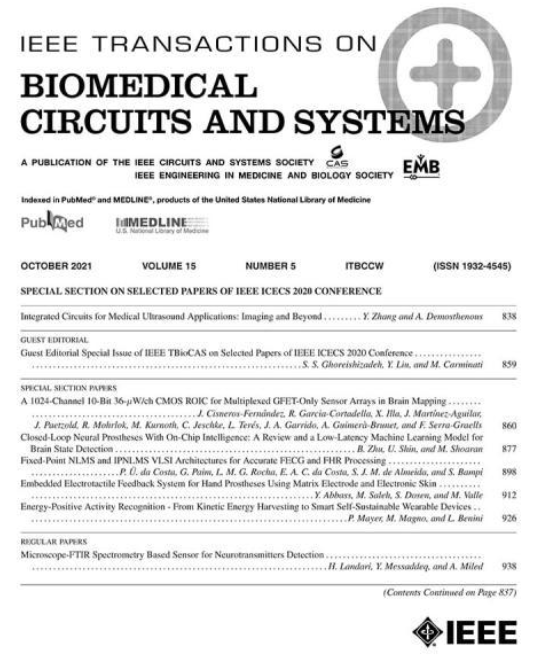Graphical Features of Functional Genes in Human Protein Interaction Network.
IF 4.9
2区 医学
Q2 ENGINEERING, BIOMEDICAL
IEEE Transactions on Biomedical Circuits and Systems
Pub Date : 1900-01-01
DOI:10.1109/TBCAS.2015.2487299
引用次数: 8
Abstract
With the completion of the human genome project, it is feasible to investigate large-scale human protein interaction network (HPIN) with complex networks theory. Proteins are encoded by genes. Essential, viable, disease, conserved, housekeeping (HK) and tissue-enriched (TE) genes are functional genes, which are organized and functioned via interaction networks. Based on up-to-date data from various databases or literature, two large-scale HPINs and six subnetworks are constructed. We illustrate that the HPINs and most of the subnetworks are sparse, small-world, scale-free, disassortative and with hierarchical modularity. Among the six subnetworks, essential, disease and HK subnetworks are more densely connected than the others. Statistical analysis on the topological structures of the HPIN reveals that the lethal, the conserved, the HK and the TE genes are with hallmark graphical features. Receiver operating characteristic (ROC) curves indicate that the essential genes can be distinguished from the viable ones with accuracy as high as almost 70%. Closeness, semi-local and eigenvector centralities can distinguish the HK genes from the TE ones with accuracy around 82%. Furthermore, the Venn diagram, cluster dendgrams and classifications of disease genes reveal that some classes of disease genes are with hallmark graphical features, especially for cancer genes, HK disease genes and TE disease genes. The findings facilitate the identification of some functional genes via topological structures. The investigations shed some light on the characteristics of the compete interactome, which have potential implications in networked medicine and biological network control.人类蛋白质相互作用网络中功能基因的图形特征。
随着人类基因组计划的完成,利用复杂网络理论研究大规模人类蛋白质相互作用网络(HPIN)成为可能。蛋白质由基因编码。必需基因、活基因、疾病基因、保守基因、内务基因和组织富集基因都是功能基因,它们通过相互作用网络被组织和起作用。基于各种数据库或文献的最新数据,构建了两个大型hpin和六个子网。我们证明了hpin和大多数子网是稀疏的、小世界的、无标度的、非分类的和具有分层模块化的。在6个子网中,essential、disease和HK子网的连接更为紧密。对HPIN拓扑结构的统计分析表明,致死基因、保守基因、HK基因和TE基因具有显著的图形特征。受试者工作特征曲线(Receiver operating characteristic, ROC)表明,该方法能够区分出必需基因和活基因,准确率高达70%左右。接近度、半局部度和特征向量中心性可以将HK基因与TE基因区分开来,准确率约为82%。此外,疾病基因的维恩图、聚类树状图和分类显示,某些类别的疾病基因具有标志性的图形特征,特别是癌症基因、HK疾病基因和TE疾病基因。这些发现有助于通过拓扑结构识别一些功能基因。这些研究揭示了竞争相互作用组的特征,对网络医学和生物网络控制具有潜在的指导意义。
本文章由计算机程序翻译,如有差异,请以英文原文为准。
求助全文
约1分钟内获得全文
求助全文
来源期刊

IEEE Transactions on Biomedical Circuits and Systems
工程技术-工程:电子与电气
CiteScore
10.00
自引率
13.70%
发文量
174
审稿时长
3 months
期刊介绍:
The IEEE Transactions on Biomedical Circuits and Systems addresses areas at the crossroads of Circuits and Systems and Life Sciences. The main emphasis is on microelectronic issues in a wide range of applications found in life sciences, physical sciences and engineering. The primary goal of the journal is to bridge the unique scientific and technical activities of the Circuits and Systems Society to a wide variety of related areas such as: • Bioelectronics • Implantable and wearable electronics like cochlear and retinal prosthesis, motor control, etc. • Biotechnology sensor circuits, integrated systems, and networks • Micropower imaging technology • BioMEMS • Lab-on-chip Bio-nanotechnology • Organic Semiconductors • Biomedical Engineering • Genomics and Proteomics • Neuromorphic Engineering • Smart sensors • Low power micro- and nanoelectronics • Mixed-mode system-on-chip • Wireless technology • Gene circuits and molecular circuits • System biology • Brain science and engineering: such as neuro-informatics, neural prosthesis, cognitive engineering, brain computer interface • Healthcare: information technology for biomedical, epidemiology, and other related life science applications. General, theoretical, and application-oriented papers in the abovementioned technical areas with a Circuits and Systems perspective are encouraged to publish in TBioCAS. Of special interest are biomedical-oriented papers with a Circuits and Systems angle.
 求助内容:
求助内容: 应助结果提醒方式:
应助结果提醒方式:


